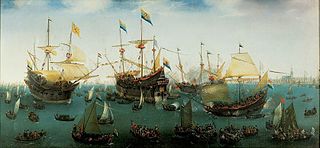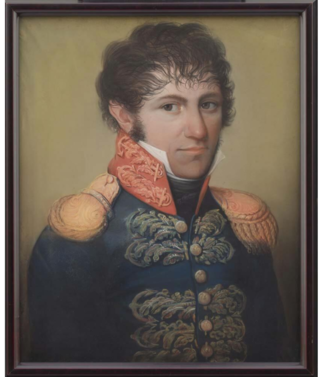Jacob Groenewegen was a Dutch merchant, who was the leading merchant (opperkoopman) on the fleet under Pieter Willemsz. Verhoeff that left Texel on December 21, 1607, and arrived in Bantam on February 15, 1609. Like Verhoeff, he died on May 22, 1609, on one of the Banda Islands, in an ambush set up by the islanders.

Johan Nieuhof was a Dutch traveler who wrote about his journeys to Brazil, China and India. The most famous of these was a trip of 2,400 kilometers (1,500 mi) from Canton to Peking in 1655-1657, which enabled him to become an authoritative Western writer on China. He wrote An embassy from the East-India Company containing the written account of this journey.

Adolphe Guillaume Vorderman was a Dutch physician and scientist whose study of the link between polished rice and beriberi in the Dutch East Indies in 1897 helped lead to the discovery of vitamins. In addition, he was an ornithologist and botanist. His great-granddaughter is British television presenter Carol Vorderman.
Martinus or Maarten Sonck was the first Dutch governor of Formosa from 1624 to 1625.

Dalem Di Made was a king of Bali who may have reigned in the period 1623–1642. He belonged to a dynasty that claimed descent from the Majapahit Empire of Java, and kept residence in Gelgel, close to Bali's south coast.
Cornelius Nicolaas Petrus Wessels was a Dutch Jesuit, known for his historical works on the early Catholic Missions in Central Asia, specially Tibet, and in the East Indies.

Willem Anthony Engelbrecht, also known as Willem Anthonie Engelbrecht, was a Dutch jurist and colonial administrator. He was one of the originators of the so-called "Dutch Ethical Policy" in the Dutch East Indies.

The Bataviaasch Nieuwsblad was one of the leading and largest daily newspapers in the Dutch East Indies. It was based in Batavia on Java, but read throughout the archipelago. It was founded by the famous Dutch newspaperman and author P. A. Daum in 1885 and existed to 1957.

Nicolaus Adriani was a Christian missionary from the Netherlands who did work in Indonesia. He studied linguistics of the East Indies at Leiden University, obtaining his PhD in 1893. He was sent by the Nederlandsch Bijbelgenootschap. He worked as a linguist in Poso, Central Sulawesi.

Cornelis Andries Backer (1874–1963) was a Dutch botanist and pteridologist. He was born on 18 September 1874 in Oudenbosch and died on 22 February 1963 at Heemstede, The Netherlands. He stayed thirty years in the Dutch East Indies and did research on plant taxonomy on the islands of Java and Madura.

A voorcompagnie (pre-company) is the naming given to the trading companies from the Republic of the Seven United Netherlands that traded in Asia between 1594 and 1602, before they all merged to form the Dutch East India Company (VOC). The pre-companies were financed by merchants from the Northern Netherlands and rich immigrants from the Southern Netherlands. Because of the deadly competition, the government forced the smaller trading companies to unite and form the (United) East India Company, that on its turn received the exclusive rights for the trade with Asia for the following 21 years.

The Compagnie van De Moucheron was a pre-company and precursor of the Verenigde Oost Indische Compagnie, from the Republic of the Seven United Netherlands. It was founded by Balthazar de Moucheron, a ship owner from Antwerp in the Southern Netherlands. After the fall of Antwerp he moved his business to Zeeland. The fleet of the Compagnie van De Moucheron was made up of three ships, 'Ram', 'Schaap' (Sheep) and the pinasse 'Lam' (Lamb) and was headed by Joris van Spilbergen. Its fleet left on 5 May 1601 and returned to the Republic of the Seven United Netherlands in 1604.

The Veerse Compagnie was a pre-company from the Republic of the Seven United Netherlands that was founded by Balthazar de Moucheron, a ship owner from Antwerp in the Southern Netherlands. After the fall of Antwerp he moved his business to Zeeland. The fleet of the Veerse Compagnie was made up of two ships; 'Leeuw' (Lion) and 'Leeuwin' (Lioness) and was headed by Cornelis Houtman. Its fleet left from Veere on 28 March 1598 and returned to the Republic of the Seven United Netherlands in 1600.
Tan Liok Tiauw Sia was a prominent Chinese-Indonesian landowner, planter and industrial pioneer in the late colonial period, best known today as the last Landheer of Batoe-Tjepper, now the district of Batuceper.
Lauw Tek Lok, Luitenant der Chinezen was a high-ranking government official and landlord in Batavia, Dutch East Indies, and a member of the Lauw-Sim-Zecha family, part of Java’s Cabang Atas gentry. He is remembered today for his long tenure as Luitenant der Chinezen of Bekasi, and for his interracial marriage with Louisa Zecha.
The Commissioners-General of the Dutch East Indies was a commission instituted by the Dutch king William I of the Netherlands in 1815 to implement the provisions of the Anglo-Dutch Treaty of 1814 and take over the government of the Dutch Indies from the British lieutenant-governor of Java, John Fendall Jr.. The commission consisted of the following three members: Godert van der Capellen, Arnold Adriaan Buyskes, and Cornelis Theodoor Elout.

Frans Friedrich Ludwig Ulrich Last was a Dutch jurist who served as Attorney General at the Supreme Court of the Dutch East Indies.
Daniel Anthony Overbeek was the last resident of Dutch Bengal between 1817 and 1825.

Andreas Johannes Ludovicus baron van den Bogaerde van Terbrugge was a Dutch nobleman, politician, author and art collector. He served as Governor of North Brabant between 1830 and 1842.

Quirijn Maurits Rudolph Ver Huell was a Dutch naval officer, writer, painter, watercolorist and entomologist. He played an important role in the suppression of the insurrection of Pattimura on Saparua in 1817. He was the captain of the Dutch ship of the line Zr. Ms. Admiraal Evertsen when that ship foundered near Diego Garcia in 1819 with an important cargo of irreplaceable botanical specimens on board, that had been gathered by the founder of the Bogor Botanical Gardens, Caspar Georg Carl Reinwardt. He was something of a polymath, who earned a reputation as a naturalist and in particular as an illustrator of works of botany, zoology and entomology. He was the last director of the renowned naval shipyard of Rotterdam. He received several high decorations, among which that of Knight 3rd class of the Military Order of William. He played an important role in the social and cultural life of Rotterdam. He was the father of Alexander Willem Maurits Carel Ver Huell.











